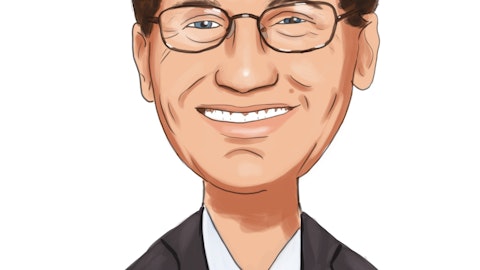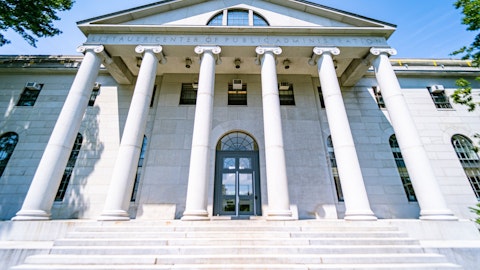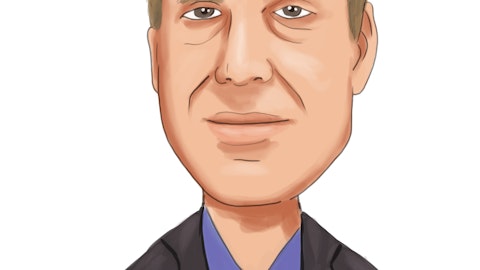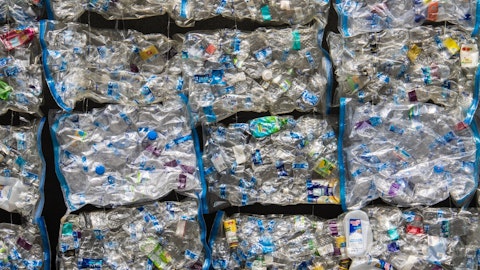Michael Hoffman: And then Larry, do you ever anticipate actually drawing down that $150 million revolver or more importantly, not drawing it down after June 30 when the spread doubles?
Larry Somma: I mean, it’s a great question. It is a committed line, so we will draw if needed. It’s a safety net though, Michael. As we reference, we’re working on other capital raises. So the view is it’s there if we need it but we’re evaluating other alternatives, because this line is not intended to be the permanent longer term solution for Augusta.
Michael Hoffman: So if I’m reading between the lines, you will avoid drawing down on it beyond the 30th, so you might between now and then repay it, but your intention is to have better sources at lower cost on a long term basis compared to the spread ramp that’s in that revolver?
Larry Somma: That’s right. I mean, anybody that looked at the 8-K would see that the spread does ramp during the period of term, which incentivizes us to have something in place so that we are not dependent on it certainly in the later stages of the term.
Michael Hoffman: And then to meet the AEDA, the Augusta Economic Development Authorities deadline, what dollar amount has to be raised by the 30th? I’m assuming it’s not all of it, but some portion has to be.
Larry Somma: Yes, it’s not entirely. We have had a number of discussions with them and we have talked about providing them assurance for one line, which they are comfortable with. So you can imagine the neighborhood of financing we need to present to them is in the, call it, $400 million to $450 million range. Now keep in mind a good portion of that has already been spent, as we have referenced. So the financing hurdle to present to them is not that full $400 million, because when we raised the equity last year, a significant portion of those proceeds have been used for financing both lines one and two
Michael Hoffman: So in simple round numbers, you’ve got an incremental $200 million to $250 million you got to come up with?
Larry Somma: That’s fair. And $150 million was announced already with a line of credit as a source for that. Again, that’s more of the safety net and we plan to replace. But that is a committed line of capital that would work for purposes with the AEDA.
Michael Hoffman: So the bigger comment to the market is you are not sitting here under duress having to raise a big number. You actually have to raise a little bit more incrementally in order to be compliant with that and then can continue to make good decisions about the cost of that capital as you need it?
Larry Somma: Yes, I mean that’s a great comment. And Dustin and I have been visiting with the AEDA monthly in their meetings and have shared a lot of information, and they are aware of our situation, it’s a mutually beneficial meeting that takes place. So you are right. We have always stressed that we want to maintain optionality and have complete financial flexibility, that’s one of the reasons we got the forbearance, because the AEDA agreed with us that having a gun to our head didn’t give us the best opportunity to raise capital in the most effective manner.
Operator: Our next question is coming from Noah Kaye of Oppenheimer.
Noah Kaye: I’d like to pick back up on Michael’s first question, which is kind of really walking through the execution milestones and starting up the plant. So you have given us a picture of what has to happen over the next four weeks for mechanical completion. Can you talk us through just a little bit the process of beginning initial pellet production, what that looks like? And I guess just generally, how you get comfortable with meeting the execution milestones laid out over the balance of the year?
Dustin Olson: So the tactical aspect of our production startup scheme will be finished mechanical completion in early April and then hand over to operations for walk downs, final punch list items, final PSSR, which is pre-safety startup review, which is what’s needed before you can introduce solvent to the system. So all of that is happening now and through the first week in April. By the middle of April, we will have finished the commissioning of the extruder that have the damaged electrical parts. The moment that that happens, we will start introducing feed to the system and also start making product from the system, that’s a middle to second half of April type timeframe. And that will drive the, let’s say, the first PIR, post-industrial recycle, production.
Beyond that, it will be a, let’s say, a discussion, an observation and a decision by operations as to how quickly we ramp production at the facility. Whenever you have a new technology or a new plant like this, you have to get it started, see how it operates, learn how to operate it effectively and then see where the constraints are. And so we will be doing all of that in the April, May, June timeframe and ultimately building up production to meet the 50% rate requirement and 100% rate requirements. We believe that we have ample time in the schedule to do these activities. And so we’re thankful for the work with the bondholders to work with us on milestones that we were comfortable with.
Operator:
Dustin Olson: Noah, go ahead and put yourself back in the queue and we’ll bring you back to the top. I think we probably cut you off a little too short there. Sorry about that. Okay. Lisa, let’s go ahead and give the floor back to Noah again please.





